From Abundance to Acute Marginality: Farms, Arms, and Forests in the Central African Republic, 1988–2014
From the Series: The Central African Republic (CAR) in a Hot Spot
From the Series: The Central African Republic (CAR) in a Hot Spot
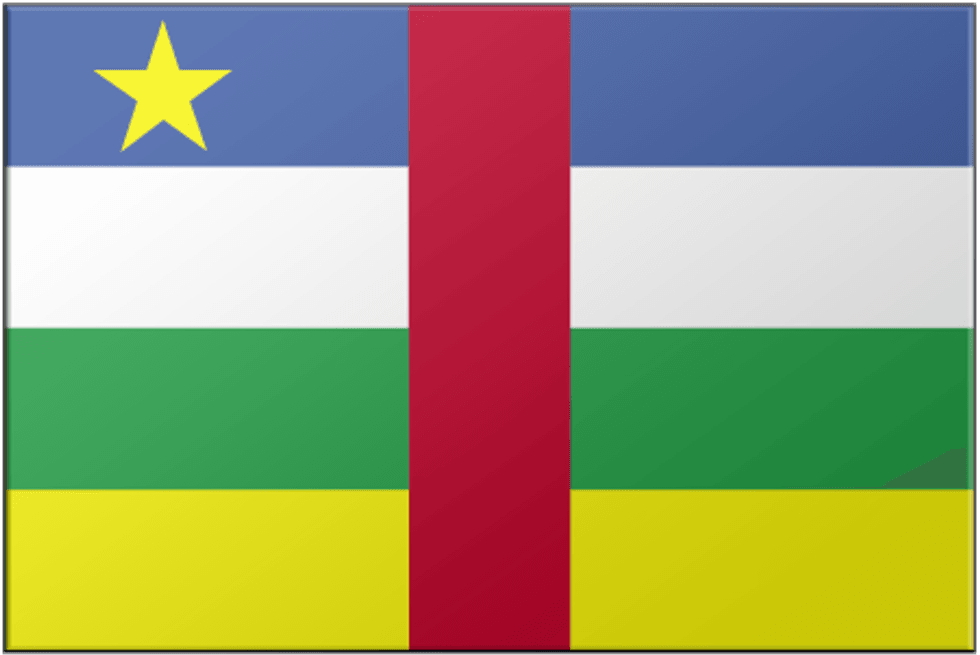
We mark with near disbelief the descent of the Central African Republic (CAR), a water- and food-abundant country, into a situation where famine risk structures massive humanitarian aid. In this essay, we offer a history of our engagement as scholars in CAR to shed light on this precipitous decline, while offering case-based ecological and biometric indicators of linked environmental and human health from the country’s key biodiversity conservation zones. We argue for the urgency of addressing the way current conflict exacerbates ongoing marginalization of vulnerable and resource-base-dependent rural residents. Specifically, while our fledgling data-collection efforts regarding food security challenges in and around the town of Bayanga, in southwestern CAR, have been interrupted by this conflict, preliminary data-analysis shows the greatest vulnerability for precisely those who consume the fewest resources and are most dependent upon their immediate environment, such as forest foragers or “Pygmies.”
Most reports on the recent conflict in CAR have focused heavily on the capital and northern prefectures. Little is recorded about southwestern CAR, yet this region is of key strategic interest to all involved for its timber, diamonds, minerals industries, as well as the megafauna of interest to tourists and hunters. Many of our colleagues in wildlife conservation in the region are veterans of the wildlife wars further north that were already raging in the 1980s. They relocated their conservation focus to southern forests in the early 1990s in the hope that the delicate balance of low human densities and high, varied wildlife populations could be protected from more militarized extractive networks linking CAR to its neighboring countries, and to global economies for natural resources.
In 2011, an opinion piece by Nicholas Kristof in the New York Times boasted the byline, “Bayanga, Central African Republic,” and described CAR as perhaps “the most wretched country in the world: life expectancy is 38, and every year it falls by another six months. One-fifth of children die by the age of 5. Outside the capital, government is only a rumor.” Yet he titled his editorial, “Where the Gorillas and the Antelope Play,” and seemed utterly seduced by the idea of a conservation zone in a corner of the country, housing Italian scientists, American ethnomusicologists, and “forest people.” We recall reading his closing lines with some irony, noting his predictable romanticism about “wild Africa.” Now we are more inclined to be thankful for such calls for attention: “In the audacious dream to preserve this rain forest and the way of life of people in it,” wrote Kristof, “you see Africa’s glory, fighting to survive.”
Phrases such as “Africa’s glory” for us are most justified when applied to cultural ecologies of abundance and interdependence that have been wrought for generations within families and communities in CAR, despite centuries of collective suffering at the hands of slave trades and colonial administrations. Central African rural ecologies mix horticulture, gathering, fishing, hunting, beekeeping, agriculture, and skills of ceramics, basketry, and trap construction. They are adaptive due to elaborate economic exchange relations across clans and language groups. Theirs is a brand of rural cosmopolitanism that includes interspecies as well as intercultural diversity. They deserve better historiographies and ethnographic records; they deserve support and protection.
By reflecting on our own distinct experiences in varied rural regions of CAR, we hope to illuminate the particular dangers of the recent conflict for women and wildlife-dependent populations, even as we pay tribute to the resilient rural livelihoods that are among the most tragic losses to CAR, its neighbors, and the world in the recent violence.
In the late 1980s, Remis was conducting pilot research in the southwestern Sangha Mbaere prefecture, marveling at the high densities of gorilla, elephant, chimpanzee, and other wildlife species. Local populations depended on wild game and other local resources. Forest forays yielded porcupines, small antelopes, tortoises, nuts, yams, mushrooms, wild greens, caterpillars, and honey. Guided by local BaAka or forest foragers, with whom she lived, she planned her return for a longer-term doctoral study. In the years of research on gorillas and wildlife populations that followed, she found long-term local residents were eager to put wildlife protection in place, given increasingly higher rates of in-migration in the area, displacing their own spear and net hunting practices.
At the same time, Hardin was a beekeeping volunteer for the U.S. Peace Corps, based in a small village and working among the towns of Boaur, Bozoum, Bouca, and Bocaranga, in the regions that are today the epicenter of armed (and, increasingly, sectarian) conflict in CAR. Honey production in the latitudes of Central Africa is among the highest anywhere on the planet, in part because these are ecological fragmentation zones between forest and savanna, with remarkable biodiversity of all kinds. Traveling by trail bike, Hardin worked up to twenty miles into the bush with Gbaya-speaking families of beekeepers who were maintaining extremely diverse subsistence practices in small clan groups along watersheds in defiance of Emperor Bokassa-era orders to “consolidate” along roadsides for taxation and rural development initiatives.
In our respective introductions to CAR, we were each initiated into internally varied examples of what a new generation of sustainability scholars have termed a “logic of sufficiency.” This phrase refers to limited consumption, but also to “localization” systems whereby few accumulate great wealth or consume goods and services at transnational scales, but most thrive through diverse and interconnected activities that produce minimal negative environmental impacts. In CAR, regional scales of intergroup exchange practices have anchored decades—if not centuries—of food security and resilience to shocks, both social and climatological.
While the productive homesteads and hunting camps of CAR’s grasslands have been forced at gunpoint to surrender their produce during the past few decades of arms trade and political insecurity in the broader region (see, for example, the reports from 2008 on rebel armies in rural CAR by BBC journalist Mike Thompson), those in the southern forests appear, at least initially, to stand a better chance of distancing themselves from militias by fleeing far from roads and towns (although, see recent expressions of concern about southern forests). So while security concerns mean that denser settlements for farming and herding are trending in northern areas, in the southern regions, we have seen groups who had been drawn to roadsides for cash employment now retreating back into the forest. These converse trends make blanket aid or relief efforts inappropriate for a country with such varied ecosystems, culture groups, and infrastructure.
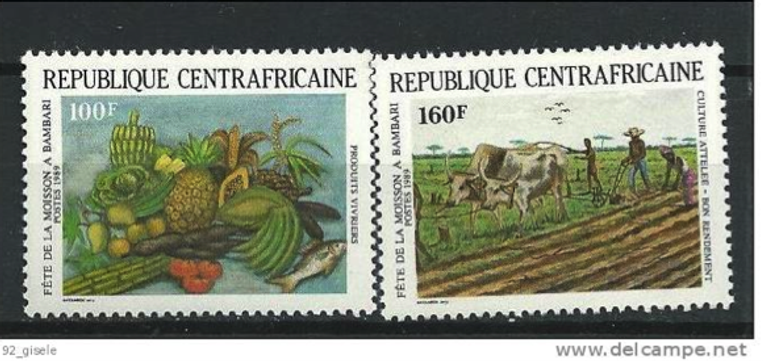
Back in the 1980s and early 1990s, collective rituals at local, regional, and national scales celebrated the country’s food abundance. Rural residents attended weekly markets and also annual Fêtes de Moisson or harvest festivals. These nation-wide celebrations fielded teams of dancers and contingents of exceptionally productive farmers from prefectures all across the country. They would travel to one of half a dozen major regional centers for the festival, bearing the biggest squash, the fattest cows, and the best drums each region had to offer.
These occasions also marked collective relief that—despite the relatively recent shadow of Bokassa’s tyranny, and the many lapses in fiscal and political accountability of the single party state under Andre Kolingba—life was good for many in the country. However, the clouds were gathering. HIV would soon cut a wide swath through the educated, elite circles of CAR, destabilizing families and national institutions.
By the early 1990s, Remis was finalizing data collection for her doctorate while Hardin extended her Peace Corps contract and moved to Bayanga for a third year of service. The expansion of the state and international capital since independence in the 1960s had brought the logging and diamond industries, increased agricultural production, and many accompanying laws to bear on many Central Africans, even in the regions like the Dzanga Sangha Reserve (or RDS), considered most “remote” from Bangui. The reserve was officially gazetted as a multi-use protected area in 1990, and was originally zoned to provide community-hunting zones to allow for the persistence of traditional hunting with nets and spears by BaAka residents, as well as more integrally protected Park sectors including the core around the Dzanga saline.
Planners did not anticipate, however, the rising levels of in-migration and increased access to guns within RDS. A boom and bust logging economy and a perception of job availability in the conservation sector attracted migrants to the town of Bayanga (from one-thousand people in the late 1980s to nearly ten thousand in 2005, settling back down to nearly six thousand). Nor had local low-impact subsistence ecologies been bolstered by development approaches such as community-based microfinance and forest management that, while intended to increase equity, have also been shown in rural Africa to amplify cash dependence and even fostered enmity among groups who are rivals for access to forest resources. By the mid-to-late 1990s, we were collaborating on a research design to document such challenges within the Reserve, even as mutinies in Bangui created waves of refugees or temporary migrants into the southwestern forests for food and security. We realized that transnational forces were as important to eventual social and environmental outcomes there as any local policies.
By 2000, militarization had come to much, if not most, of the country’s territory. In 2003, we read with sinking hearts a report in The Lancet about falling life expectancies and rising infant mortality rates over time in CAR. We respectively and together revised our research agendas to better understand human health crises, and address them alongside conservation policies and politics. Throughout CAR’s long postcolonial history of power struggles, as in so many simmering civil conflicts, the continual losers are civilians, especially women and children. In this respect all the recent political changes mask terrible underlying continuities of suffering.
So it is less an overnight occurrence than one might assume, reading a October, 15, 2013, statement by the International Medical Corps, that the current conflict in the wake of Seleka and Djodotia’s bid for power disrupts agricultural livelihoods in CAR, indirectly by making zones unsafe, and directly through the looting of cattle, seeds, tools, and already-meager food reserves. What has happened, instead, is a tipping point in longer-term trends that remain of grave concern. “More than 390,000 people in CAR have been internally displaced,” notes Melanie Wissing, the Internal Displacement Monitoring Centre’s assistant country analyst for CAR. This amounts to roughly ten percent of the population of the country and may well be an underestimate.
In Bayanga and the surrounding region, the costs of recent conflict come to bear on communities already under stress due to the cumulative effect of economic and demographic changes, alongside conservation policies and punitive anti-poaching activities. Many BaAka have reduced forest use and reliance on animal proteins, except for those who are lucky enough to have cash to purchase meat from gun hunters.
We have recently begun collecting information on nutrition and health outcomes that may result from decades of changing subsistence and lifestyle patterns and decreasing access to wildlife. From June–August 2012, Remis and Jost Robinson collected information at RDS on households, nutritional status, and diets in interviews in Mossapoula and Yandoumbé villages. These data show that health status among the BaAka at RDS is gendered; women are generally more vulnerable to food insecurity and subsistence changes than men. The short-term nutritional status of those living in zones where hunting is most restricted was most affected.
These were painful results for us to acknowledge, coming as they did among a group of women many of whom had mentored and accompanied us as young scholars, “showing us around their forest” in times of greater abundance and encouraging us to partner with conservation projects. Moko, pictured at Remis’s left in the below photo, was a younger woman who connected with Remis in the early 1990s when her husband (now deceased) was valued for his highly specialized knowledge of gorilla tracking. A photo of Moko from 1990 appears below the more recent picture. The two photos may help to convey the physical changes in those women who have been able to hang on, and raise children, despite reduced access to forest resources and increased conflict in Bayanga.
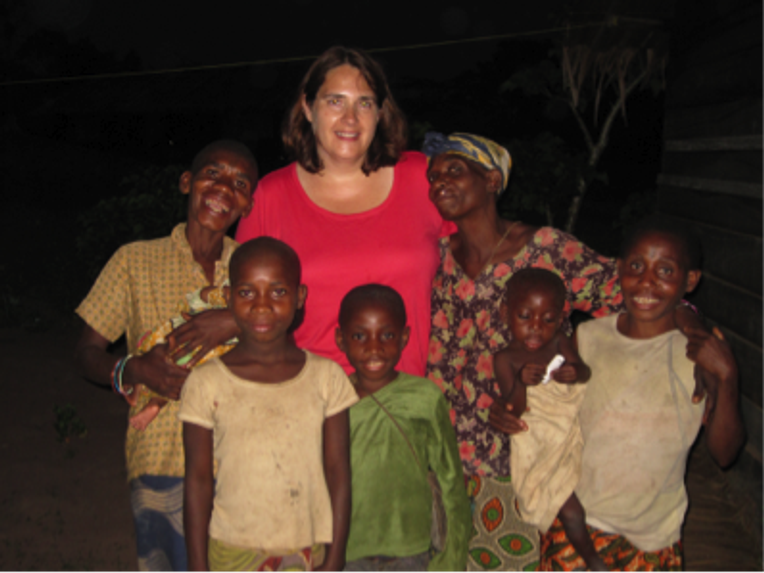
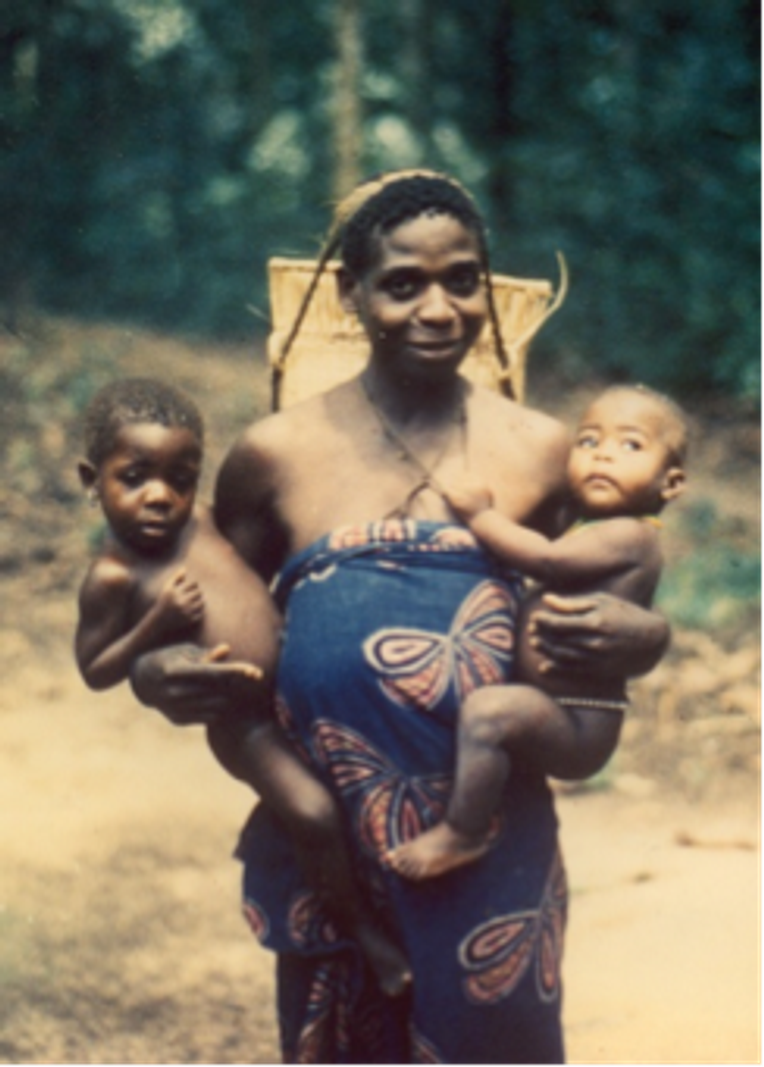
Even before the crisis and disruption of the food base, Remis and Jost Robinson found that fifteen percent of female BaAka sampled had a body mass index (BMI) that would be considered chronically energy deficient. The poor health (low BMI, low hemoglobin, parasitic infections) was extreme among middle-aged and older women who were working as day laborers in Bilo fields to help support their children and grandchildren, coming home with only a few small handfuls of manioc for their day’s work. These findings are especially sobering when viewed relative to the higher hemoglobin levels and other health measures reported from research on BaAka in the RDS region in 1968, before logging or conservation activities had commenced.
It is disheartening to see health decline so closely tied to socioeconomic changes at RDS (and also in nearby forager populations) and specifically to the conservation management policies of the last twenty-five years. In the push to attract big budgets to conserve forests and wildlife, and to create zoning laws in the 1980s, conservationists and government ministers alike neglected to adequately take into account the consequences for food security of local populations dependent upon wild game and other forest resources. The food base was further compromised in 2012 because of poor manioc yields and an increase in crop damage by elephants pushed into the RDS area during active logging in adjacent Congo. The combination resulted in looming famine, previously unknown in this region.
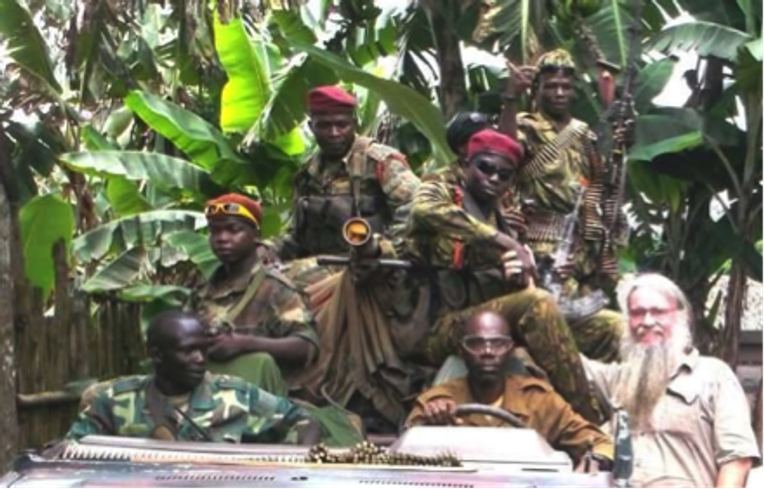
Into the midst of this steady erosion of health and security, young rebels from the north arrived in May 2013, escorting potential investors in the region from Asia for a visit. These young soldiers had come far from their own war-torn families. Alienated in other ways than the forest peoples around them, they came defensively bearing semi-automatic weapons from their jeeps. On arriving in Bayanga, they immediately went door-to-door inquiring about and conducting searches for firearms; those who were found to have guns were beaten, and jailed for several days. One of our informants, upon being released from jail, fled the area to the bush further north in which relatives had cultivated fields and where he felt he would be less visible. In so doing, he abandoned a long history of employment with the RDS conservation project, as well as an artisanal business selling “bamboo” roof tiles. His wife, who stayed behind, had made their home a haven for many orphans in the area who had lost parents to HIV and other infectious diseases, or whose own parents did not have large enough fields to feed their families. While it is possible that the widespread removal of firearms could provide a temporary boon to wildlife populations, the subsistence tool represented by a good hunting gun is a vital part of the rural households around Bayanga. There removal leaves many feeling crippled with respect to getting meat in their stewpots more than once a week.
Communities of Africanists must find ways to continue following and engaging in research and partnership with populations in the Central African Republic, documenting the unexpected costs of decades of less-than-appropriate polices. The dismal data about the health of women in even the most resource-rich corners of CAR notwithstanding, we hope for transcendence of intellectual and philanthropic discourses that simply substitute wildlife and humans in Africa as the centers of discourses about victimization and vulnerability. We need recognition and protection of the robust traditions that have long connected them as communities, and made Africa the last repository of wild populations of many animal species.
There can be no turning back of the hands of time for CAR, no containment of perils from just over its borders, and beyond. There can, however, be a louder, more moving lament for what is being lost on the African continent as CAR’s population submits to these overlapping waves of violence, many of which are importing new and terrible technologies of torture to a country whose humanity has all too often been mocked, even by its own leaders. We recognize that in this text we risk naïve recourse to nationalism in today’s geopolitically transforming Africa, or to advocacy in today’s more critically edged or scientific anthropology. We also risk recourse to nostalgic longing for negotiations within and among communities in an increasingly militarized command-and-control conservation sector. Perhaps these are not risks, but steps toward confronting seemingly insurmountable challenges for some of Africa’s most important remaining expanses of socially and ecologically diverse landscapes. In that diversity, great resilience has historically been found, and continued resource abundance. Both of these attributes are crucial to an African continent confronting with new intensity the problems of climate change, demographic transitions, and heightened roles as a global repository for energy, mineral, and natural resources. Though that Africa (or, rather those Africas) may not allow CAR localized self-sufficiency, nor a role as food-security crucible for neighboring regions where conflicts and climates have historically been more severe, the efforts of other African powers to terminate the Djodotia presidency and instill new bases for a viable CAR nation-state should not be squandered. They must be supported, not only by what Andreas Mehler has termed the private security forces for elite protection shown to contribute to spiraling insecurity, but rather at the basic household level, with many hands working together.